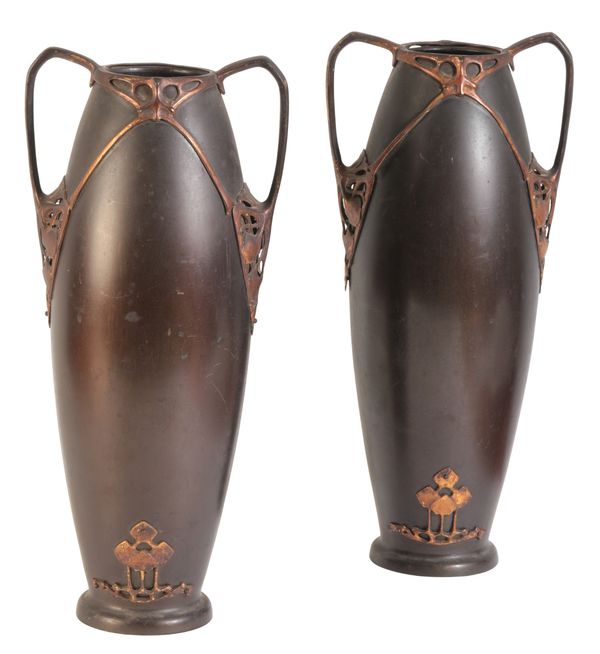probably designed by Englebert Kayser (1840-1911) and Hugo Leven (1874-1956), bronze, of tapering form, with applied foliate decoration and twin handles, Kayser eagle mark to the base, each 38.25cm high
| Condition Report: | click here |
| Estimate: | £200 - £400 |
The biggest German pewter factory of the 19th century originates from a little family business: Johann Peter Kayser was born in Cologne in 1813 and in 1844 he founded a small foundry in Kaiserswerth. 7 years later the family moved to Krefeld, where they inaugurated a new tin foundry.
In 1864 Johan Peter Kayser’s eldest son, called Engelbert Kayser, opened an atelier which offered a view on the German and European artistic craftsmanship of that time and in 1885 his brother Jean Kayser, heir of his father’s foundry since 1874, built the “Leuconide- und Metallwarenfabrik J. P. Kayser Sohn” in Krefeld-Bockum.
In 1890 Engelbert Kayser decided to lead the factory alongside artists and designers Hugo Leven and Karl Geyer. The collaboration between Engelbert, Leven and Geyer led to the development of the first collections and services in 1901, including pieces featuring floral relief designed by Leven.
In 1900, during the Paris worldwide exhibition, Engelbert Kayser received a gold medal as the main designer of the Kayserzinn factory in Krefeld, whose production increased due to this important praise. In this period Leven and Fauser began to use clay and plasticine and developed a new technique called “Daumendrückrelief”, by which the relief was less perceivable and decorations appeared nearly engraved, in bas-relief.
From 1902, when Kayserzinn got a second worldwide praise, to 1904 more than 100 new models were invented and Karl Berghof presented innovative conic and cylindrical forms.
In 1904 Kayserzinn received its last praise at the world exhibition in St. Louis (USA) but from this moment the production started to diminish and Leven and Fauser left their job at the atelier.
Engelber's death in Cologne in 1911, swiftly followed by the outbreak of the First World War and the increasing price of the rough tin caused the abandonment of the atelier.
Some surface wear and verdigris evident, gilding very dirty, no obvious dents, dings or repairs

